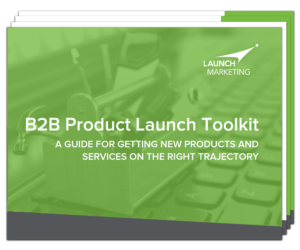
Launching a new product or service is no easy feat. Arming yourself with an integrated marketing plan is essential for delivering a successful and impactful launch. Without a well-thought-out plan, important but easy-to-miss details can slip through the cracks and leave you scrambling as launch day approaches.
An integrated marketing plan for your new product or service should combine research, marketing and messaging strategies to ensure that every aspect of promoting your launch is executed in a cohesive manner. This blog outlines three vital steps to building a solid integrated marketing plan for launching your product and supporting its long-term success.
Set clear goals for your launch
The first step in developing an integrated marketing plan is to define clear objectives for your launch. In order to design these goals accurately, take the time to conduct and compile thorough research of your competitive landscape and target audiences. This work will allow you to set realistic goals that are backed by a firm understanding of your market.
Begin with overall business objectives you’re hoping to accomplish. For instance, are you looking to fill the top of your sales funnel, create awareness, or generate a few key lighthouse customers? Once you’ve addressed high-level considerations, concentrate on targets for your launch. Are you introducing a new product or service completely, or venturing into a brand-new industry or marketplace with an existing offering?
After articulating the overall objectives for your launch, let your budget act as a guide for the execution of your goals. While it’s tempting to stretch your funds across a frenzy of disparate activities, your resources should instead be used to maximize how effectively the combined initiatives can work to accomplish your objectives. This approach ensures that strategy and results are at the forefront of your integrated program, not exhaustible spending power.
Key takeaways:
- Define clear launch day objectives
- Research competition to set realistic goals
- Set your budget and stick to it

Looking for all the strategies and insights into successfully launching your new product or service? Download the B2B Product Launch Toolkit!
Determine which messaging and mediums to leverage
When it comes time to select which marketing mediums and messaging tactics to employ, consider all channels that are relevant for your buyer personas. Some mediums are more common and easier to integrate, such as email, online and social. Reaching out to your audience across multiple mediums can create more opportunities for engagement.
From here, design your channel selection and messaging strategy based on the behavioral patterns of your target buyers. For example, which platforms are your target personas most active on? Does he or she like to receive direct, succinct messages or thorough, detailed explanations? Even with multiple target audiences or channels, an integrated plan drives consistency across the board and promotes a recognizable brand for your new product or service.
Finally, don’t forget to consider the length and complexity of your sales cycle. For instance, if you are introducing a complex and expensive product to market, you’ll likely have a longer and more in-depth sales process designed to educate potential customers. With products like these, buyers are often willing to go to greater lengths to validate your offering prior to purchase. As a result, your channels should engage them during their validation process to help inform their purchase decision.
Key takeaways:
- Evaluate all channels available, especially commonly used ones
- Home in on how channels affect buyer behavior
- Make sure your campaign considers the complexity of your sales cycle
Integrate from the inside out
Finally, you must integrate your marketing plan from the inside out. To accomplish this, communicate your plan to market across the entire team. Involve team members in the planning process and get feedback on timelines and key deliverables: launch days typically require all hands on deck.
Be transparent about key goals and objectives so everyone is on the same page throughout the entire launch. Encourage proactive and regular communication as deliverables are completed or delayed, or if priorities shift. Additionally, seek out employees from different levels or departments and give them opportunities to provide feedback or brainstorm ideas. This level of transparency further promotes collaboration and communication throughout your organization.
Key Takeaways:
- Ensure that all relevant team members are active in launch planning
- Facilitate regular communication
- Enable team members from different departments opportunities to provide feedback
Read: B2B Product Launch Best Practices: Coordinating a Successful Team
Take every opportunity you can to integrate your marketing activities for campaigns that produce stronger results. By ensuring alignment and consistency from overall objectives down to individual marketing channels, you can set yourself up for an impactful launch, as well as a lasting future for your company.
Take the next step to build a powerful B2B marketing plan. Contact us today or request a free marketing consultation!
There are no comments